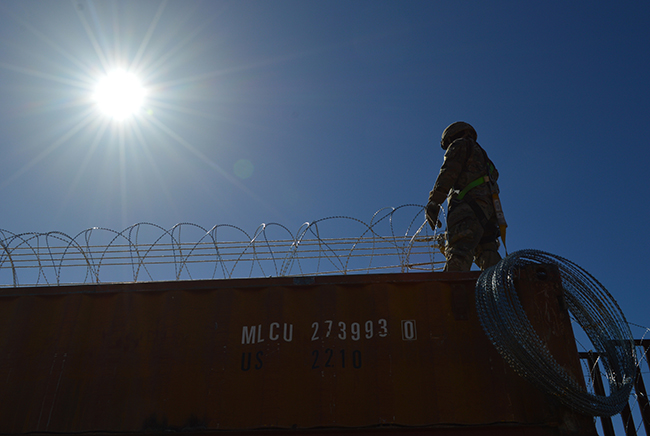
An engineer prepares to secure concertina wire to the border in Sasabe, Ariz., on Feb. 7, 2019. Army photo by Sgt. 1st Class TaWanna Starks.
Money for more than 50 Air Force-related military construction projects may be reallocated so the government can build a wall along the southern US border, according to the Defense Department.
The Air Force’s share of $3.6 billion in MILCON spans efforts such as range improvements, maintenance hangars, and operations facilities, among many others. Some projects were scheduled to improve Air Force installations, while others affect the service’s operations but are not on its property.
The Pentagon announced Sept. 4 it would divert money for 127 existing MILCON initiatives to instead fund 11 barrier projects along 175 miles of the southern border. The military needs those particular border projects to support its effort to help handle immigration issues, Pentagon spokesman Jonathan Hoffman said in a release. Congress may decide to backfill the MILCON efforts in a future budget.
The Pentagon will send border wall funding to the Army in two installations, with the first half coming from deferred overseas projects. This includes several initiatives at USAF bases and elsewhere, like an elementary school and F-22 facilities at Spangdahlem AB, Germany; a large project for deployable air base systems and war reserve materiel at Ramstein AB, Germany; C-130J hangars and facilities at Yokota AB, Japan; and RC-135 infrastructure at RAF Fairford, England. Additionally, European Deterrence Initiative-funded improvements at bases in Poland, Romania, Slovakia, and others will be delayed.
The second segment of funding, if needed, will come from deferring domestic projects in the US and its territories. Potentially impacted work at several USAF locations includes a maintenance hangar in Puerto Rico; range improvements at Eielson AFB, Alaska; a space control facility at Peterson AFB, Colo.; an MQ-9 operations facility at Holloman AFB, N.M.; a hazardous cargo pad and explosive ordnance disposal range at JB Andrews, Md.; a dining facility at JB San Antonio, Texas; a control center at the Utah Test and Training Range; cyber operations facility at JB Langley-Eustis, Va.; among others.
The full list of impacted projects is available here. Some lawmakers have pushed back on the plan, which comes as the military works through a slew of facilities problems that affect people and programs nationwide.
Sen. Jim Inhofe (R-Okla.), chairman of the Senate Armed Services Committee, said the money will allow the government to make real progress on securing the southern border without inflicting lasting readiness issues on the military. Others aren’t convinced.
“Military installations will have crucial repairs and upgrades delayed as a result of this irresponsible action by the president,” Rep. John Garamendi (D-Calif.), House Armed Services Committee readiness subcommittee chairman, said in a release. “This comes at a time when more than $11 billion is needed to repair bases that have been ravaged by recent natural disasters. We will do everything in our power to push back against this irresponsible and irrational decision.”
Editor’s note: This story has been updated to reflect that while Congress can decide to backfill the funding for impacted projects, it does not need to sign off on the initial deferment.